| Biggin's Battle of Britain Bash 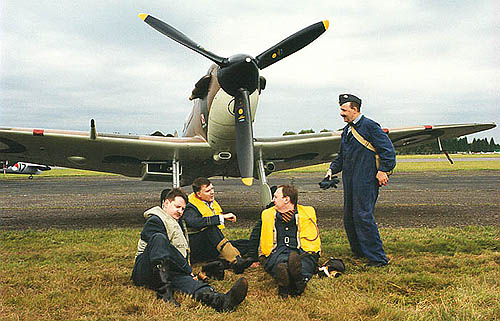 Biggin Hill
Battle of Britain Airshow, 17 September Biggin Hill
Battle of Britain Airshow, 17 September
Gary Stedman reports: Although the date
on the programme stated 17 September 2000, you could be forgiven for believing that we had
gone back sixty years to the summer of 1940, with a group of pilots
waiting patiently at dispersal playing chequers within yards of their aircraft. As soon as
the expected scramble shout comes the pilots and groundcrew jump into action, sprinting
for their fighters. The re-enactment scene at the Biggin Hill Battle of Britain Open Day
show was a nice touch - although only the Blenheim and three of the Spitfires
carried authentic 1940 RAF camouflage.
As one would expect, the show commemorated the sixtieth anniversary of the Battle of
Britain and the vital role Biggin Hill played, the airfield formerly being one of 11
Group's sector stations. Although not quite on a scale as the Duxford show the weekend
before, an impressive number of Spitfires and Hurricanes had
gathered at Biggin Hill, and others would fly in from Goodwood for the finale.
Contributions could be seen from the Dutch, Polish and French airforces past and present, a reminder that a considerable
number of foreign aircrew flew with the RAF during the War - free Polish pilots were the
largest overseas contingent to fly with Fighter Command during the Battle of Britain. The
Duxford based Blenheim also served as a reminder of the effort Bomber Command made during
the summer of 1940, attacking invasion barges on the French coast. Indeed, it is firmly
believed that the night attacks by Bomber Command on Berlin changed the course of the
battle.
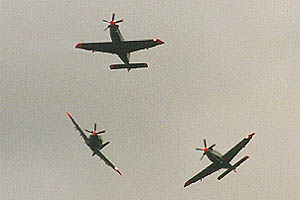 Although overshadowed by the nostalgia, the modern Royal Air Force was also
well represented - the Red Arrows being joined by the display aircraft from the Tornado (GR1 and F3), Jaguar and Harrier communities.
The early morning arrival by the Tornados surprised a few people (your scribe included),
the mixed four ship thundering into the overhead circuit, followed by a few touch and
goes. The senior service was not forgotten with displays from the Historic Flight
Swordfish and a pair of Lynx HMA8s, flying as the 'Lynx Duo'. Besides the always excellent
Red Arrows, the Polish Air Force Orlik team was the only other national display team
present, their five home-produced PZL-130TC trainers flying a four
ship formation and singleton display. Although overshadowed by the nostalgia, the modern Royal Air Force was also
well represented - the Red Arrows being joined by the display aircraft from the Tornado (GR1 and F3), Jaguar and Harrier communities.
The early morning arrival by the Tornados surprised a few people (your scribe included),
the mixed four ship thundering into the overhead circuit, followed by a few touch and
goes. The senior service was not forgotten with displays from the Historic Flight
Swordfish and a pair of Lynx HMA8s, flying as the 'Lynx Duo'. Besides the always excellent
Red Arrows, the Polish Air Force Orlik team was the only other national display team
present, their five home-produced PZL-130TC trainers flying a four
ship formation and singleton display.
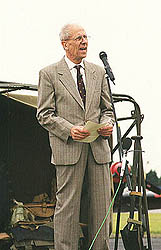 Following
a parade of military vehicles along the crowdline, the first commemorative set piece was
staged. A tribute to 'The Few' was read by Lord Tebbit (himself a former pilot), following
which a planned seven Spitfires and two Hurricanes would scramble for a three 'vic'
flypast. With one of each type dropping out, seven took to the skies, performing a series
of fly-bys before returning. Only the BP tanker shattered the illusion that we were indeed
back in the 1940s - although fuel might well have been easier to acquire back then than
the week before the Biggin Hill show! Following
a parade of military vehicles along the crowdline, the first commemorative set piece was
staged. A tribute to 'The Few' was read by Lord Tebbit (himself a former pilot), following
which a planned seven Spitfires and two Hurricanes would scramble for a three 'vic'
flypast. With one of each type dropping out, seven took to the skies, performing a series
of fly-bys before returning. Only the BP tanker shattered the illusion that we were indeed
back in the 1940s - although fuel might well have been easier to acquire back then than
the week before the Biggin Hill show!
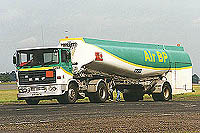 At
least two of the Spitfires were carrying markings applied for their appearance in the
forthcoming Disney Pearl Harbour film. Upon hearing of their role some time ago, I was
quite surprised - surely not even Hollywood could place RAF Spitfires over Pearl Harbour
in December 1941! (Its director, Michael Bay is a filmmaker not noted for letting realism
come before style - have you seen Armageddon?). It turns out however, that some of the
sequences will show a Fighter Command 'Eagle' squadron during 1941, with four Spitfire V/VIIIs having been marked with fake serials (AR4474(??)) and 'RF'
codes. A quick check of the reference books shows that 'RF' was assigned to 303 (Polish)
Squadron who flew Hurricanes in 1940/41 before converting to Spitfires. The film opens
next year. At
least two of the Spitfires were carrying markings applied for their appearance in the
forthcoming Disney Pearl Harbour film. Upon hearing of their role some time ago, I was
quite surprised - surely not even Hollywood could place RAF Spitfires over Pearl Harbour
in December 1941! (Its director, Michael Bay is a filmmaker not noted for letting realism
come before style - have you seen Armageddon?). It turns out however, that some of the
sequences will show a Fighter Command 'Eagle' squadron during 1941, with four Spitfire V/VIIIs having been marked with fake serials (AR4474(??)) and 'RF'
codes. A quick check of the reference books shows that 'RF' was assigned to 303 (Polish)
Squadron who flew Hurricanes in 1940/41 before converting to Spitfires. The film opens
next year.
The inclusion of one of the resident ex-Yugoslav Air Force Galebs
in the flying programme seems to have provoked a critical response from the tabloid press.
Whatever the politics now, it seems ironic that the Serbs fought alongside the allies
against their German occupiers sixty years ago. The Battle of Britain Flight flew down
from RAF Coningsby before their display slot minus a Hurricane. It was only later that it
became apparent that a Hurricane had indeed departed Coningsby, the aircraft having to
make a emergency landing en-route at Seething in Norfolk. The rumours of a B52 flyby were
found to be slightly exaggerated - it was never planned.
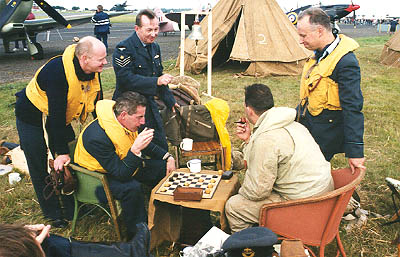 The commentary team really should have known better than to jest
about the Dutch F16s mistaking Kenley for Biggin Hill while we were awaiting their
arrival, as they did indeed fly past in the distance seemingly intent on a scenic tour of
Kent before returning for a single fly-by; locating a particular airfield in unfamiliar
territory still seems to be a problem sixty years after the battle. The Tornado F3 display
still looks impressive, despite having watched it several times this summer - 56(R)
Squadron's display aircraft again was noticeably absent (rumour has it that it is now at
St Athan, undergoing a 'major' and will lose its Firebird markings). Ironically, it could
be argued with some justification that the F3's counterpart sixty years ago was the German
Messerschmitt BF 110, a heavily armed twin designed as a long range fighter. Goring
considered the Zerstorer (destroyer) Gruppes to be the Luftwaffe's elite, but it was when
encountering more agile interceptors over their home turf that their superiority was
questioned. The similarities in roles between the F16 and Spitfire are obvious. The commentary team really should have known better than to jest
about the Dutch F16s mistaking Kenley for Biggin Hill while we were awaiting their
arrival, as they did indeed fly past in the distance seemingly intent on a scenic tour of
Kent before returning for a single fly-by; locating a particular airfield in unfamiliar
territory still seems to be a problem sixty years after the battle. The Tornado F3 display
still looks impressive, despite having watched it several times this summer - 56(R)
Squadron's display aircraft again was noticeably absent (rumour has it that it is now at
St Athan, undergoing a 'major' and will lose its Firebird markings). Ironically, it could
be argued with some justification that the F3's counterpart sixty years ago was the German
Messerschmitt BF 110, a heavily armed twin designed as a long range fighter. Goring
considered the Zerstorer (destroyer) Gruppes to be the Luftwaffe's elite, but it was when
encountering more agile interceptors over their home turf that their superiority was
questioned. The similarities in roles between the F16 and Spitfire are obvious.
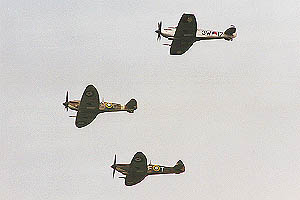 The finale was another staged set-piece, the
crowd being invited to imagine the date was 18 August 1940 - a day when Biggin Hill came
under heavy attack from a Dornier formation. The pyrotechnics team had the time of their
lives as the fighters taxied out (the speed with which the airport fire department reacted
suggests they went a little overboard). Of course, there was a certain amount of poetic
license required, it's unlikely back in 1940 they would have taxied the length of the
runway to scramble, or bother to use it even if one was available. After taking off
through the smoke, the formation was joined by a further group of Spitfires from Goodwood.
The eighteen Spitfires and Hurricanes
returned, led by Charlie Brown for a series of fly-bys before breaking away for their
various destinations, the low sun providing a fitting backdrop. Ray Hanna provided the
final act, a solo aerobatic display in the OFMC MkIX before departing to the sounds of the
'Last Post'. Although by The finale was another staged set-piece, the
crowd being invited to imagine the date was 18 August 1940 - a day when Biggin Hill came
under heavy attack from a Dornier formation. The pyrotechnics team had the time of their
lives as the fighters taxied out (the speed with which the airport fire department reacted
suggests they went a little overboard). Of course, there was a certain amount of poetic
license required, it's unlikely back in 1940 they would have taxied the length of the
runway to scramble, or bother to use it even if one was available. After taking off
through the smoke, the formation was joined by a further group of Spitfires from Goodwood.
The eighteen Spitfires and Hurricanes
returned, led by Charlie Brown for a series of fly-bys before breaking away for their
various destinations, the low sun providing a fitting backdrop. Ray Hanna provided the
final act, a solo aerobatic display in the OFMC MkIX before departing to the sounds of the
'Last Post'. Although by
now you could be forgiven for saying "not another Spitfire display" at the end
of a long day, Ray Hanna proved again, if it was really needed, that he is the master of
the solo Spitfire routine.
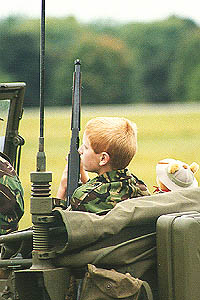 In recent years it's become quite fashionable amongst the enthusiast
network to view the attendance of the Red Arrows at a event as a necessary evil, comments
such as "chance to get the static" or "pop to the loo" are frequently
heard. It's almost as if it is thought that their presence is just to attract Joe public,
the "professional" spotter having seen it all before. Consider this, for as the
Reds were in full swing, beside me was an elderly gent wearing a jacket emblazened with
the Bomber Command crest (clearly a man not easily impressed), who was totally overawed,
the whole routine holding him captivated. In recent years it's become quite fashionable amongst the enthusiast
network to view the attendance of the Red Arrows at a event as a necessary evil, comments
such as "chance to get the static" or "pop to the loo" are frequently
heard. It's almost as if it is thought that their presence is just to attract Joe public,
the "professional" spotter having seen it all before. Consider this, for as the
Reds were in full swing, beside me was an elderly gent wearing a jacket emblazened with
the Bomber Command crest (clearly a man not easily impressed), who was totally overawed,
the whole routine holding him captivated.
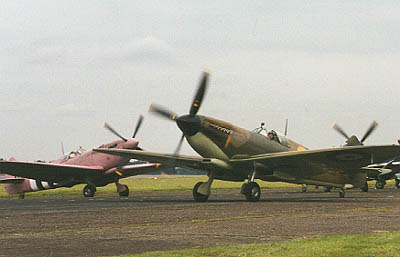 As a first time visitor to Biggin Hill, in my
opinion it was certainly worth the wait, the show drawing the right balance between a
Battle of Britain salute 'Duxford style' and showcasing the current Royal Air Force. The
dispersal re-enactment was particularly well done. As always, there are a few points that
would seem to need improvement - the programme magazine, although informative, seemed
overpriced at £5 - and you would have thought somebody would have noticed the Harrier two
page spread photograph was a FA2 instead of the captioned GR7. But, most seriously, was
the attempted exit at the end of the show - if you were there you will already know what's
coming. I counted myself lucky in being able to get out in just over two hours, the
marshalling towards the one known exit clearly inadequate. As a result, for some this may
well have been their first (and last) airshow they will ever attend. As a first time visitor to Biggin Hill, in my
opinion it was certainly worth the wait, the show drawing the right balance between a
Battle of Britain salute 'Duxford style' and showcasing the current Royal Air Force. The
dispersal re-enactment was particularly well done. As always, there are a few points that
would seem to need improvement - the programme magazine, although informative, seemed
overpriced at £5 - and you would have thought somebody would have noticed the Harrier two
page spread photograph was a FA2 instead of the captioned GR7. But, most seriously, was
the attempted exit at the end of the show - if you were there you will already know what's
coming. I counted myself lucky in being able to get out in just over two hours, the
marshalling towards the one known exit clearly inadequate. As a result, for some this may
well have been their first (and last) airshow they will ever attend.
|